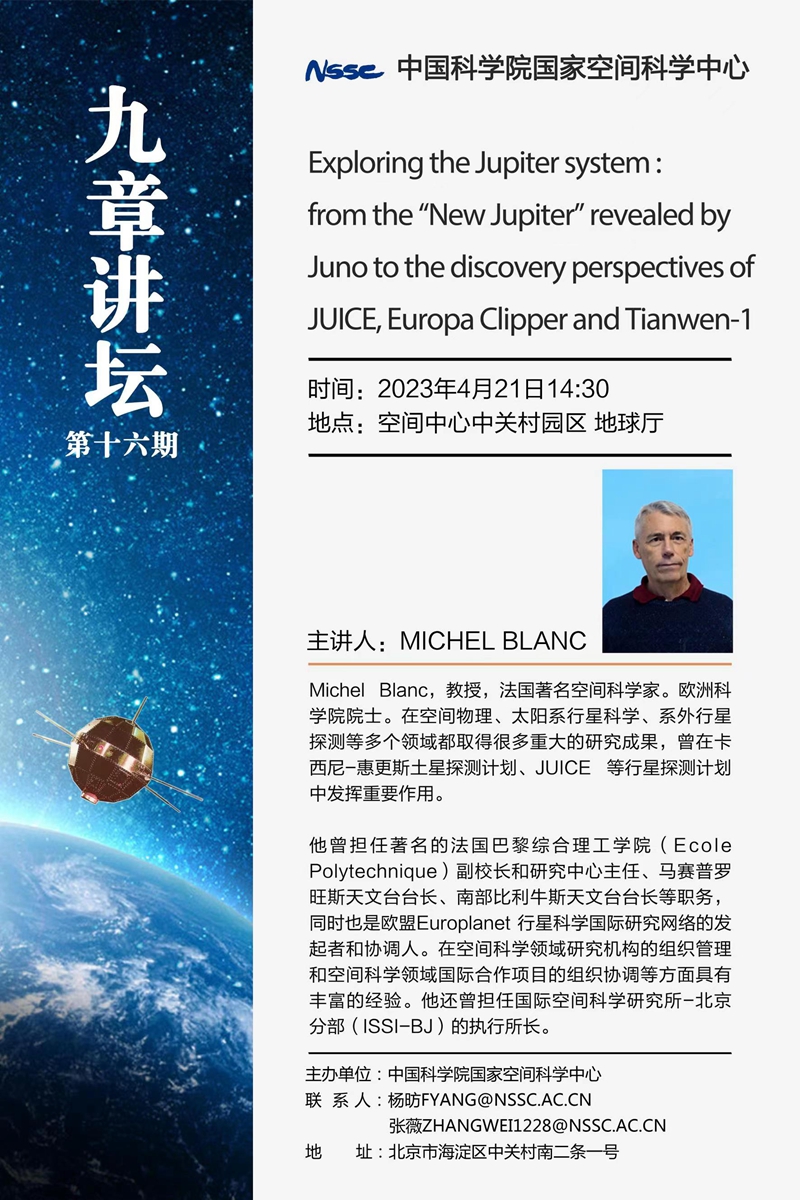Exploring the Jupiter system :from the “New Jupiter” revealed by Junoto the discovery perspectives of JUICE, Europa Clipper and Tianwen-1
Michel Blanc*
Emeritus professor
Institut de Recherche en Astrophysique et Planétologie (CNRS-Université de Toulouse-CNES), Toulouse, France
*also visiting professor at NSSC, CAS
The Jupiter system is one of the best models available to us in the solar system for the study of planetary systems in a broader sense. As presented in our recent book "Planetary Exploration, Horizon 2061", Jupiter system exploration addresses all the key open science questions about planetary systems: diversity of objects, diversity of architectures, origin and formation of planetary systems, how they work, the search for habitable worlds, and ultimately the search for life in the Universe. NASA's Juno mission, currently in orbit around Jupiter, in which we are actively participating, reveals to us a “new face" of Jupiter: its internal structure, its highly structured and turbulent atmsophere, its magnetosphere and ionosphere, its interactions with the Galilean moons, and finally the surprising disk of magnetized plasma created around Jupiter by the volcanic activity of the moon Io.
A new wave of missions to Jupiter has been opened on April 14th, with the successful launch of ESA’JUICE mission. Europa Clipper (NASA) should follow at the end of 2024. After them, new important missions to Jupiter will be needed at the 2030 horizon and beyond to deepen our exploration of Jupiter and its moons: China’s TianWen mission will offer a unique opportunity to unravel the formation scenario of this system, study its magnetosphere to large distances, and explore some of its most poorly known moons, including Callisto. A new ESA project for a mission to a moon of a giant planet is proposed in the framework of ESA's Voyage 2050 new long-term science program. We hope that this host of wonderful missions will open great opportunities for many scientific collaborations between all nations.
Presentation Michel Blanc
Short Biography
Michel Blanc is a space plasma physicist and planetary scientist working at IRAP, Toulouse, France. He is also for part of his time an associate scientist at the LAM, France, and at the University of Michigan, USA. He has been the director of two astronomical observatories in France, vice-president for research of Ecole Polytechnique, Paris (2007-2012), Executive Director of ISSI-Beijing (2016-2018) and several times a visiting professor at NSSC, CAS, China.
His research focuses on the coupled magnetosphere-ionosphere-thermosphere systems of Earth and giant planets and on the comparative study of Planetary Systems and planetary magnetospheres. He performed intensive studies of the Earth’s ionosphere and of its coupling across latitude regions to the magnetosphere using the incoherent scatter radar technique and MIT coupling models. He has been an Interdisciplinary Scientist on the Cassini-Huygens mission to Saturn and Titan. His current interests strongly focus on (1) the Jupiter system, through his participations to Juno and JUICE and to the study of future missions to giant planets;
(2) the Earth’s magnetosphere-ionosphere-atmosphere system and its internal and external coupling processes, as a participant to the China-led IMCP project.
Michel Blanc has published about 150 articles in peer-reviewed international journals. He is a member of the Air and Space Academy, of the International Academy of Astronautics, and of the Academia Europaea.


